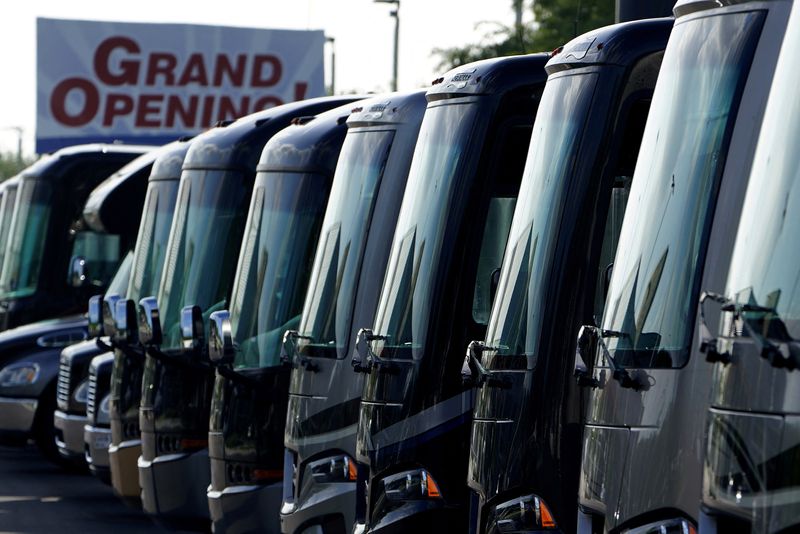

© Reuters. FILE PHOTO: Recreational vehicles (RVs) for sale at a dealership in Dover, Florida, US, are pictured on June 20, 2019. Reuters/Carlo Allegri/File photo
2/2
by Timothy Appel
(Reuters) – The U.S. economy may have finally escaped recession, but it’s felt that way for months at John Ferrando’s 103 RV dealership.
Retail sales of recreational vehicles are on track to be their lowest since 2015, said Ferrando, CEO and president of Fort Lauderdale, Florida-based Blue Compass RV, which operates in 33 US states. “There’s definitely a downturn in RVs,” he said.
Blame the coronavirus pandemic. Few industries better reflect the wild shift in American spending habits during the health crisis.
Within months, consumers cut back on spending on services, as restaurants closed and airports turned into ghost towns, and began spending on goods, particularly items such as RVs, bicycles, and swimming pools. Anything that made quarantine conditions more tolerable saw a huge increase in demand.
Michael Happe, CEO and President of Winnebago Industries (NYSE: ), called it “Covid retail mania” when speaking to investors.
But problems surfaced soon after pandemic restrictions were eased and US interest rates began to rise. The Federal Reserve has hiked borrowing costs 10-fold since last March as part of an aggressive drive to control high inflation. The US central bank’s benchmark overnight interest rate rose 5 percentage points to the 5.00%-5.25% range, the highest level in nearly a decade and a half.
Interest rates are well above what consumers pay on loans, Ferrando said, and RV loans have recently averaged around 10% versus 7% or so before the Fed’s higher levels of monetary tightening. 80% of his company’s customers finance their purchases, so it was only natural that a rapid increase in rates would pique buyers’ appetite.
‘Screaming Recession’
As soon as the demand dried up, the manufacturers put on the brakes. According to the RV Industry Association, North American shipments of new motorhomes and trailers, nearly all of which are produced in the United States, are expected to decline to 300,000 this year, roughly half the number shipped in 2021. The only other time shipments declined so sharply was during the 2007–2009 financial crisis and recession.
Winnebago and Thor Industries (NYSE: ), the largest U.S. RV maker, declined to discuss how they are adjusting to the downturn, but investors seem to think the worst is over. Shares of Elkhart, Indiana-based Thor and Eden Prairie, Minnesota-based Winnebago are up 46.5% and 29%, respectively, on a year-to-date basis.
“Our industry has always faced a bit of a challenge forecasting demand,” said Jason Lippert, CEO of LCI Industries (NYSE: ), a major supplier of parts to the RV industry, also based in Elkhart.
That shortfall was compounded during the pandemic, he said. “During Covid, dealers took whatever they could — as long as it was an RV.”
Recession in this business has long been considered a reliable recession gauge, but that may not apply this time.
“If I were just looking at the RV data, I would be screaming recession,” said Michael Hicks, an economics professor at Indiana’s Ball (NYSE: ) State University who tracks the industry. He said the decrease in RV shipments has signaled every US recession since 1981. But the flood caused by a rare event like an epidemic has spoiled the general picture.
RVIA spokeswoman Monica Geraci said the industry faces a dual challenge: Inflation has driven up sticker prices and high interest rates have made it expensive to finance large purchases like RVs.
“We expect shipments (of RVs) to start rising again in the second half of this year,” Geraci said. RVIA estimates that shipments in North America will reach about 350,000 units next year “as consumers get more comfortable with the level of inflation and the level of interest rates,” he said.
older and more expensive
The problem for many dealers is unsold RVs in their lots. RV industry consultant Greg Fore, who previously ran an RV parts supplier, said that half of the new inventory at some of the dealers he works with is 2022 models. This figure would normally be around 20% to 25%, he said.
Dealers are now faced with the prospect of bringing in the latest 2024 models that cost less than these older models. “How do you sell a ’22 that’s more expensive than a ’24?” Fore asked.
Meanwhile, other sectors that saw a pandemic-related boom have also been battered — though in many cases not as hard as RV.
Tyler Harmon, vice president of sales and marketing at Pools of Fun, a large in-ground pool builder in Indiana, said their backlog of orders for new pools has shrunk to about three months — compared to the year-long wait that customers saw at the peak of the pandemic.
“I would say volume-wise and revenue-wise we are still ahead of where we were pre-Covid – so we are not completely regressive,” he added.
There is also optimism in Blue Compass. The company moved quickly to sell off its backlog of used RVs, Ferrando said, and its service business remains strong as existing customers continue to need repairs and upgrades.
“There’s still interest in RVing,” he said, “but customers are just more cautious.”